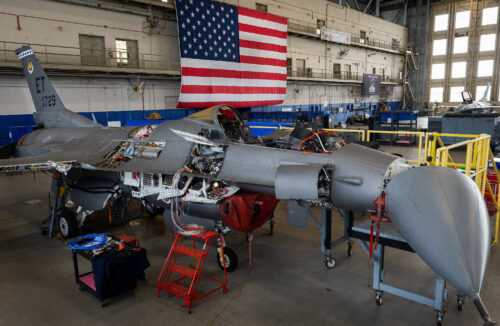The Viper Experimentation and Next-gen Operations Model – Autonomy Flying Testbed (VENOM) program received its final F-16 Fighting Falcon on Apr. 1, completing the fleet that will be modified for autonomous aircraft testing.

U.S. Air Force photo by Samuel King Jr.
The arrival completes the aircraft collection phase for the program, which aims to accelerate testing of autonomy software on both crewed and uncrewed aircraft. The VENOM program serves as a critical component in the Air Force’s development of autonomous aircraft capabilities.
In a nearby hangar, three F-16s are already undergoing extensive modifications. These adjustments include specialized software, hardware, and instrumentation installations that will eventually allow autonomous systems to control the aircraft.
“Modifying the aircraft is the result of a rigorous design phase and brings us one step closer to testing autonomy on a fighter jet with real mission systems and capabilities,” said Maj. Trent McMullen, the 40th Flight Test Squadron’s advanced capabilities division chief.
A notable physical addition to the aircraft is the auto-throttle system. This modification enables the autonomous software to regulate not only the flight control surfaces but also the thrust of the aircraft.
While the physical modifications continue, the autonomous systems that will eventually control the VENOM aircraft are being tested in simulation environments. These simulations, which began in 2024, initially focused on one-on-one air combat scenarios and have now progressed to more complex two-on-two engagements. The simulated missions include both within-visual-range and beyond-visual-range scenarios.
“These simulations provide an efficient way to train the autonomy to learn complex air combat tactics,” McMullen explained. “A specific scenario can be run 1,000 times and the variations and decisions made throughout that mission can be studied. We can then make recommendations to the developers on how to improve the autonomy’s behaviors and overall performance.”
The next phase of development for the VENOM program will focus on hardware and software-in-the-loop testing. Software testing will ensure the autonomous systems properly interface with the aircraft’s systems, while hardware testing will emphasize safety parameters.
“Test engineers will confirm autonomous commands cannot break the aircraft or harm the pilot,” McMullen said. This testing ensures the autonomous system cannot exceed operational limits or flight envelope restrictions regardless of the commands given. These tests will be conducted using an F-16 flight simulator.
Safety protocols remain central to the VENOM project, with test pilots maintaining a “human-on-the-loop” role throughout the development process. When the aircraft begins actual flight testing, a test pilot will be on board to oversee operations with the ability to activate or deactivate the autonomous systems in real time.
Testing will be carried out by the 40th Flight Test Squadron and the 85th Test and Evaluation Squadron. The 40th Flight Test Squadron will handle developmental testing aspects, while the 85th Test and Evaluation Squadron will focus on operational testing requirements.
“Having both developmental test and operational test pilots working and flying from the same location allows for daily collaboration and reduces the stove piping of knowledge and lessons learned,” said Lt. Col. Jeremy Castor, VENOM operational test lead.
This collaborative approach has accelerated the program’s progress. Officials anticipate that within approximately 18 months of the first F-16s arriving, a fully modified aircraft will be ready to begin testing.
“As the VENOM program’s first flight approaches, we are excited to test novel autonomous solutions. The strides we’ve witnessed in the simulation environment suggest VENOM will help advance aerial combat capabilities for future crewed and uncrewed platforms,” said McMullen.
For more information, hit the Source below